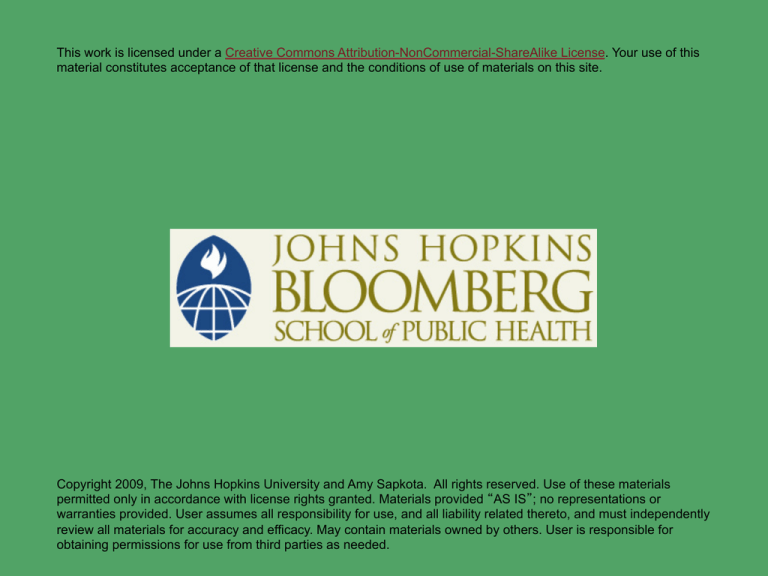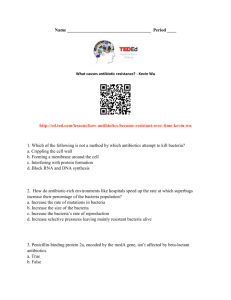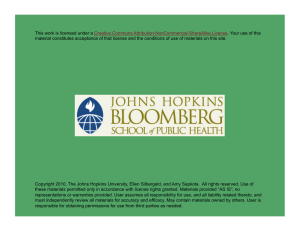
This work is licensed under a Creative Commons Attribution-NonCommercial-ShareAlike License. Your use of this
material constitutes acceptance of that license and the conditions of use of materials on this site.
Copyright 2009, The Johns Hopkins University and Amy Sapkota. All rights reserved. Use of these materials
permitted only in accordance with license rights granted. Materials provided “AS IS”; no representations or
warranties provided. User assumes all responsibility for use, and all liability related thereto, and must independently
review all materials for accuracy and efficacy. May contain materials owned by others. User is responsible for
obtaining permissions for use from third parties as needed.
Research—Water and Air Quality around CAFOs
Amy R. (Chapin) Sapkota, PhD, MPH
Johns Hopkins University
Background
n
Swine CAFOs can pose threats to public health as sources of
chemical and biological agents
n
Ambient air can be contaminated by the release of odor, gas, and
dust plumes
n
Surface waters and ground waters can be contaminated by manure
wastes
n
Respiratory, gastrointestinal, and mental health problems have
been documented among workers and neighbors
3
Swine Odor, Gas, and Dust Plumes
n
More than 160 chemical compounds
n
Gases: hydrogen sulfide, ammonia,
carbon dioxide
n
Volatile organic compounds
n
Particulate matter (PM10, PM2.5)*
n
Bacteria and fungi
*PM10—particulate matter 10 microns and less in size
PM2.5—particulate matter 2.5 microns and less in size
4
Water Contaminants Associated with Swine Manure
n
High levels of nitrates and phosphates
n
Heavy metals, including arsenic and
copper
n
Bacterial and viral pathogens
n
Antibiotic residues
n
Antibiotic-resistant bacteria?
5
Transfer of Antibiotic-Resistant Bacteria
Antibiotics
in animal
feeds
Production of
animal feeds
Pets
Community
Meat
products
Selection of
antibiotic-resistant
bacteria in animals
Feces,
manure,
sewage
Surface
water
Irrigation of
vegetable crops
Humans
Air?
Ground
water?
Source: (1998). Canadian Medical Association Journal. 159, 1129–1136.
Hospitals
6
Swine CAFO Exposure Assessment Study
7
Study Objectives
1. To test air samples collected
within a swine CAFO for the
presence of antibiotic-resistant
bacteria
2. To test surface water and ground
water samples upstream and
downstream of a swine CAFO for
the presence of antibiotic-resistant
bacteria
8
Methods: Air Sampling
1. Obtained access to a swine CAFO
2. Developed an air sampling strategy and sampled in
12/03 and 1/04 using an all-glass impinger
3. Isolated bacteria from air samples
- Standard methods used for the isolation of Enterococcus spp.
(EPA, 2000)
4. Conducted antimicrobial susceptibility testing using standard
methods (NCCLS, 2002)
- Susceptibility to erythromycin, clindamycin, virginiamycin,
tetracycline, and vancomycin was tested
Source: EPA. (2000). Improved enumeration methods for the recreational water quality indicators:
Enterococci and Escherichia coli. EPA/821/R-97/004; NCCLS. 2002. M31-A2 [ISBN 1-56238-461-9].
9
Air Handling
10
Methods: Water Sampling
1. Developed water sampling strategy and sampled from 9/02 to 1/04
- Upstream and downstream surface and ground water samples
(1L) were collected
2. Isolated bacteria from water samples
- Standard membrane filtration methods used for the isolation of
Enterococcus spp. (EPA, 2000)
3. Conducted antimicrobial susceptibility testing using standard
methods (NCCLS, 2002)
- Susceptibility to erythromycin, clindamycin, virginiamycin,
tetracycline and vancomycin was tested
Source: EPA. (2000). Improved enumeration methods for the recreational water quality indicators:
Enterococci and Escherichia coli. EPA/821/R-97/004; NCCLS. 2002. M31-A2 [ISBN 1-56238-461-9].
11
Water Testing
12
Results: Air Sampling
n
Mean concentration of airborne bacteria was 104 colony-forming
units (CFUs)/m3
n
137 presumptive Enterococcus spp.
n
Other bacterial species also were identified
13
Airborne Bacteria Isolated from a Swine CAFO
Airborne bacteria isolated from a swine CAFO using methods for the isolation of Enterococcus species
Bacteria
No. of isolates (%)
Enterococcus
47 (34)
E. avium
5 (4)
E. dispar
4 (3)
E. durans
2 (1)
E. faecalis
6(4)
E. faecium
1(<1)
E. hirae
14(10)
E. mundtii
1(<1)
E. pseudoavium
2(1)
E. raffinosus
1(<1)
Other
11(8)
Staphylococcus
44(32)
S. aureus
1(<1)
Coagulase-negative staphylococci
43(31)
Streptococcus
Viridans group streptococci
Micrococcus luteus
45(33)
1(<1)
Total
137(100)
Adapted by CTLT from: Chapin et al. (2005). Environmental Health Perspectives, 113, 2, 137–142.
14
Results: Air Sampling
n
Regardless of bacterial species, 98% of all isolates were multi-drug
resistant, expressing high-level resistance to at least two antibiotics
n
None of the isolates were resistant to vancomycin, an antibiotic
that has never been approved for use in the U.S.
15
Results: Air Sampling
Phenotypes of antibiotic resistance among airborne bacteria collected from a swine CAFO
Chapin et al. (2005). Environmental Health Perspectives, 113, 2, 137–142.
16
Results: Water Sampling
n
200 presumptive Enterococcus spp.
n
Mean concentrations of drug-resistant Enterococcus spp. were
-
-
n
102 CFUs/100mL in surface water
10 CFUs/100mL in ground water
Ground and surface water isolates downstream of the CAFO
displayed patterns of antibiotic resistance similar to those observed
in the airborne isolates
17
Antibiotic Resistance Results: Water Sampling
n
Preliminary antibiotic resistance results: water sampling
- Antibiotic-resistant non-E. faecalis Enterococcus spp. in ground and
surface water downstream and upstream of a swine CAFO
Source: Chapin et al.
18
Conclusions
n
High levels of multi-drug-resistant bacteria are present in CAFO air
and in surface and ground waters downstream
n
CAFO workers and growers are at high risk of exposure to airborne
isolates
n
Neighbors could be exposed to both airborne and waterborne
resistant bacteria through inhalation or ingestion
n
Air and water contaminated by swine CAFOs may serve as exposure
pathways for the transfer of resistant bacteria from swine to
humans
19
Policy Implications
n
Currently, the issue of antibiotic-resistant bacteria in air or water
associated with CAFOs is not on the radar screen of the U.S.
government
n
Environmental Protection Agency
- Gases, particulate matter, volatile organic compounds in air
- Levels of bacterial indicators and nutrients in water
n
Food and Drug Administration
- Levels of antibiotic-resistant bacteria in food
n
This research suggests that the issue of resistant bacteria in the
environment surrounding CAFOs needs regulatory attention
20






